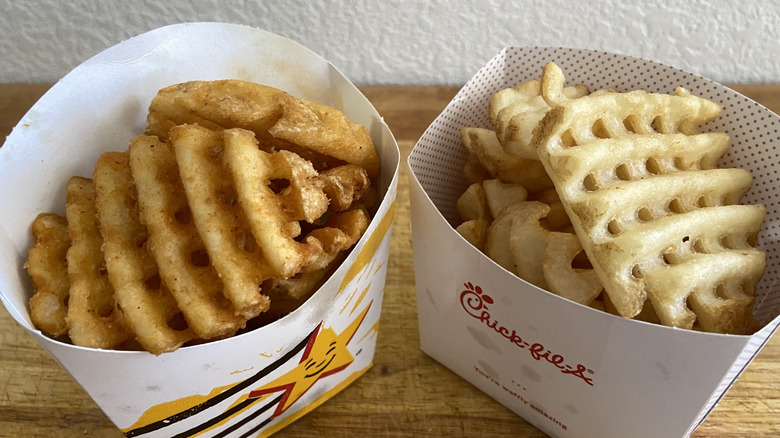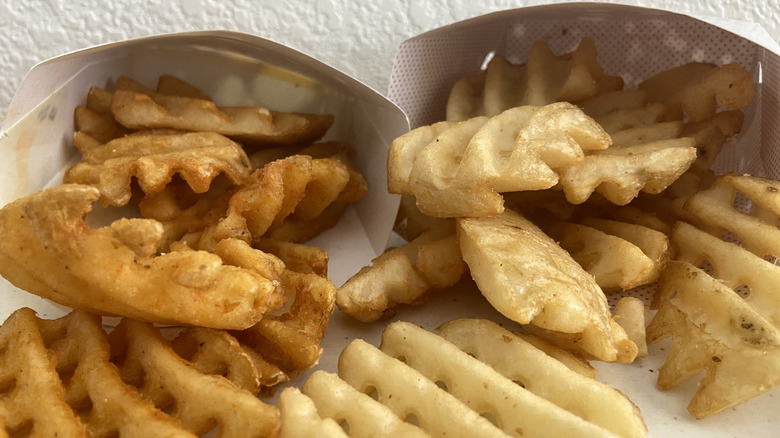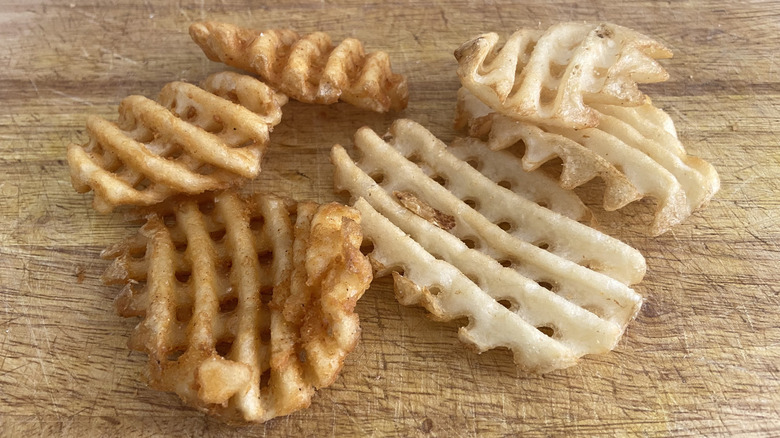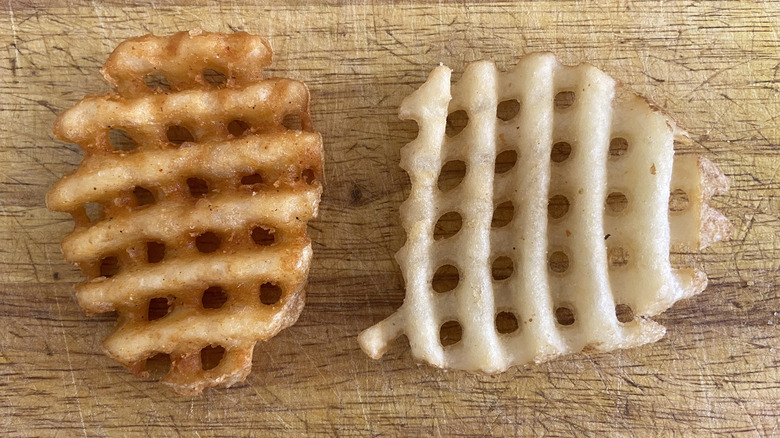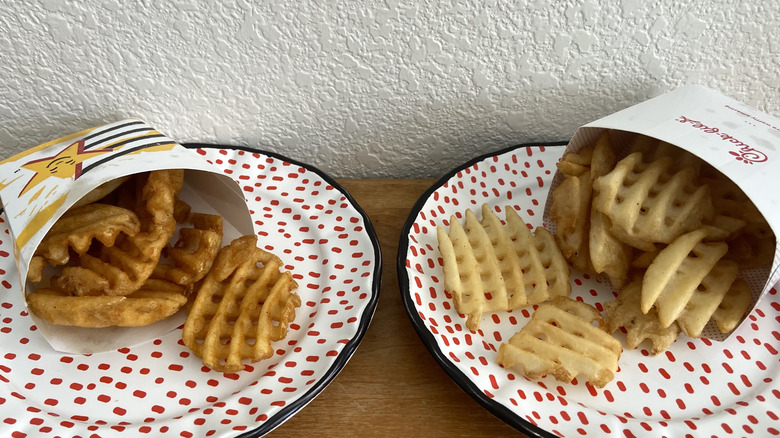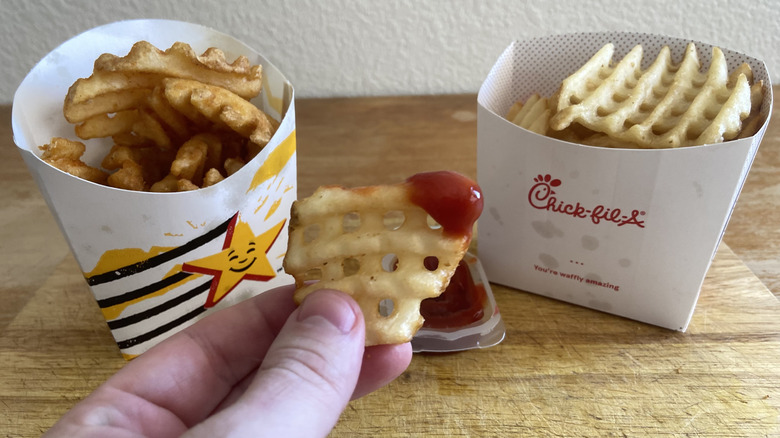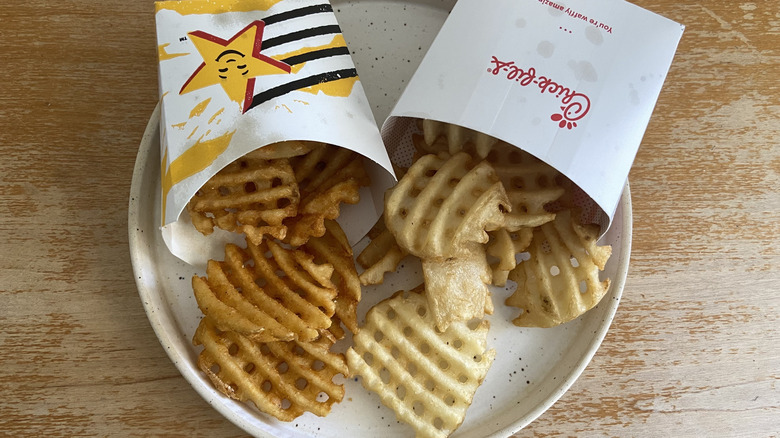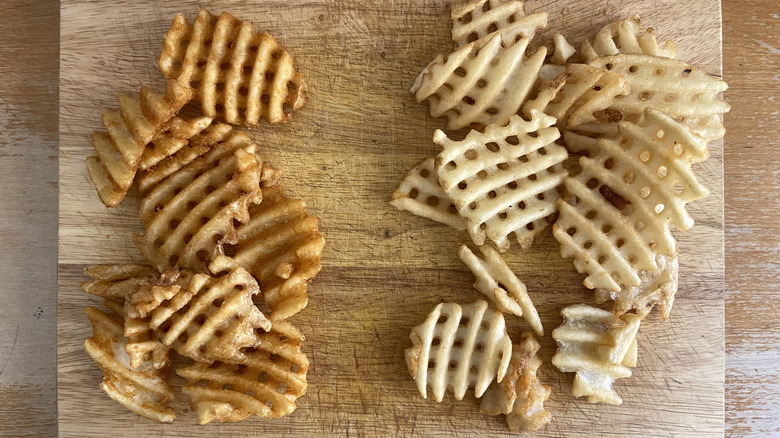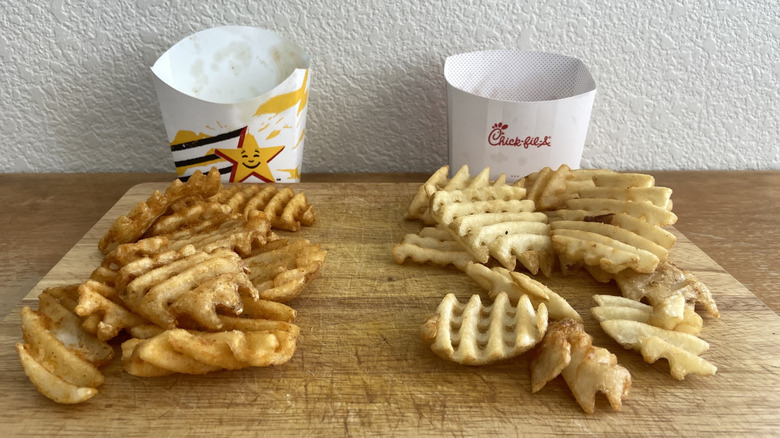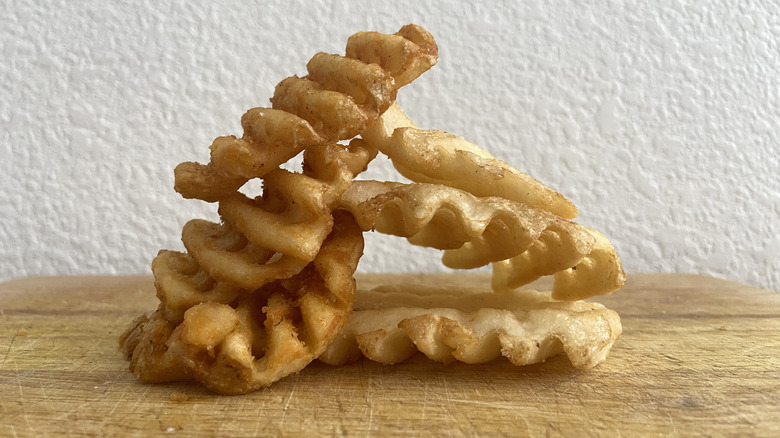Carl's Jr. Vs Chick-Fil-A: Who's The King Of Waffle Fries?
Though there may be nothing wrong with the humble french fry, nine times out of 10 a side of waffle fries is straight up better than a side of regular old fries. However, probably because cutting a potato into holey waffle shapes isn't quite as straightforward as simply slicing it into long strips, the waffle fry is relatively uncommon in the world of fast food. Nevertheless, despite whatever challenges the potato preparation may pose, Carl's Jr. and Chick-fil-A are the two foremost fast-food chains bringing waffle fries to the masses.
In order to determine whose waffle fries reign supreme, I sat down with an order from each restaurant and compared them in eight categories before deciding which waffle fry was better overall. As it turns out, Carl's Jr. and Chick-fil-A do quite a few things differently, turning this head-to-head into a clash between two distinct waffle fry-making philosophies. Of course, in the end, only one fast-food chain can sit on the crispy, oily, crisscut throne as the indisputable king of waffle fries. Read on to find out who it is.
Who makes the better-looking waffle fries?
Appearance may well have less of an impact on enjoying a side of french fries than, say, a burger from a fast-food restaurant. Simply put, it's harder to mess up the look of deep fried chunks of potato than it is a dish with more than one main ingredient. That said, anyone who's been to Carl's Jr. and Chick-fil-A more than a couple of times could probably pick each chain's waffle fries out of a lineup because of how immediately distinct they look from one another.
For what it's worth, there are valid reasons to prefer the look of either style of waffle fry — though I have a favorite. Chick-fil-A, notably, opts for a waffle fry that retains as much of its natural potato character as possible. That means a neutral off-white color accented by bits of brown potato skin. Meanwhile, the Carl's Jr. fries are an unmistakable shade of orange. Some fries retain their potato skin too, but that's subsumed by a prevailing orange color. The Carl's Jr. fries also look quite a bit crispier, diverging from the naturalistic appearance of the Chick-fil-A fries here too. At a glance, the Carl's Jr. fries look like they would taste better than Chick-fil-A's. Their orange hue plainly indicates flavor, whereas the natural but bland Chick-fil-A style looks like it would require a dipping sauce to enjoy.
Whose waffle fries are seasoned best?
With plenty of past experience eating both Carl's Jr. and Chick-fil-A waffle fries, I had a pretty good idea going in of how each chain would hold up in the seasoning department. Based on my assessment of their appearances or even just a glance at the two styles of fry side-by-side, I anticipated the results to be pretty unsurprising. That said, I maintained an open mind while analyzing each waffle fry's seasoning to come up with this determination — keeping past experience and appearance out of mind as much as possible — even if the result was still the expected one.
First off, the Chick-fil-A waffle fries are salted liberally just like any good fast-food french fry. Because of an altogether minimalist style of preparation, a natural potato flavor is pretty apparent when you take a bite without any dipping sauce. While the plain potato flavor is effectively absent in the Carl's Jr. waffle fries, whatever techniques the chain uses to both crisp up the exterior and turn the waffle fries orange ends up imbuing them with a brash, robust flavor profile. Double-frying is key to making french fries extra crispy, and that's likely part of the equation. So, while Chick-fil-A waffle fries are adequately seasoned and of a high enough quality to taste like fresh potato, their simplicity ends up equating to dullness. Carl's Jr., meanwhile, utilizes a bolder and overall superior seasoning blend, resulting in a fry that tastes uniquely great.
How does the texture of each waffle fry compare?
Texturally, Chick-fil-A's waffle fries are lightly crispy on the outside and soft on the inside. Combined, these two consistencies clash a little bit, as the initial crisp gives way to a significantly mushier interior. This approach to texture matches the other ways in which Chick-fil-A seems intent on preserving as much fresh potato character as possible, given that the inner softness somewhat approximates a baked potato in consistency.
The waffle fries from the trendsetting Carl's Jr. chain are more texturally cohesive. While they too are crispier on the outside and softer on the inside, a greater level of crispness and a comparatively thicker crispy layer help the two consistencies mesh with one another. Whereas a Chick-fil-A fry bite can sort of transition from crisp to soft, the ratio at play in the waffle fries at Carl's Jr. helps them better maintain some crunch throughout each bite. Overall, Carl's Jr. waffle fries are texturally superior to the competition at Chick-fil-A.
Whose waffle fries are larger on average?
Naturally, just like any style of french fry, the size of each individual waffle fry at both Carl's Jr. and the storied Chick-fil-A chain can vary pretty significantly. That said, in my assessment, one chain pretty handily maintained a larger average waffle fry size compared with the other.
Based on physically measuring a few fries with a ruler and mentally comparing the ones I measured to the rest of the batch, the waffle fries at Carl's Jr. averaged about 2 ¼ inches in length. The longest Carl's Jr. fry in my batch was just under 3 inches. Meanwhile, the largest Chick-fil-A fry was a considerably bigger at 4 inches in length, while the average size among all my Chick-fil-A fries was closer to 2 ½ inches. The sole caveat that slightly complicates this category was a higher number of loose fry bits in my Chick-fil-A batch compared to what I got at Carl's Jr. Ultimately, I considered those non-fries insignificant and didn't factor them into my average. That aside, even just a glance at both batches of fries made it clear that, at least based on my respective visits, Chick-fil-A's waffle fries are larger overall than those at Carl's Jr.
Which style of waffle fry is better for dipping?
One metric in which Carl's Jr. and Chick-fil-A waffle fries are not all that different from one another is their shape. Both are sufficiently grooved and, at their best, just slightly curved — elements that provide ample surface area and an ideal curvature for dipping.
In order to determine which style of waffle fry was better for dipping, I turned instead to their respective flavors. The Carl's Jr. waffle fries tasted good dipped in ketchup, but because the ketchup flavor overpowered the seasoning, I felt like the combo was inferior to that of the fries I ate plain. Comparatively, Chick-fil-A's waffle fries are tailor-made for dipping, due to their plain-ish potato flavor benefitting from some extra sauce. While the Carl's Jr. fries are perfectly fine in a dipping sauce, for someone who only enjoys their fries with ketchup, I'd recommend Chick-fil-A instead, as the waffle fries taste better with a little something extra.
Which chain offers more customization options?
Customization may not be the first thing that comes to mind when ordering fries from a fast-food restaurant, but it's a relevant factor in this face-off. First and foremost, it's worth noting that Carl's Jr. only offers its waffle fries in a single serving size. Comparatively, customers at Chick-fil-A can opt for a small, medium, or large serving of waffle fries.
Furthermore — at least when ordering online at my local location and a few other spots around the country I checked for verification's sake — the only condiment option Carl's Jr. offers is ketchup. It may well be possible to ask for another dipping sauce in-restaurant, but officially, it's ketchup or nothing. Meanwhile, at Chick-fil-A, fries can come with any one of 10+ dipping sauces and/or seasonings. Customers can even choose two different sauces with a small or medium, and up to three with a large order. Chick-fil-A's waffle fries, therefore, are exponentially more customizable than those you'll get at Carl's Jr.
How do they match up nutritionally?
Anyone indulging in a serving of fast-food waffle fries has most likely accepted that they've made an unhealthful choice. Nevertheless, with multiple options on the table, it's still valid to mitigate even the unhealthfulness of fast food and opt for whatever's the least worst.
With that in mind, a standard 120-gram serving of Carl's Jr. waffle fries totals 380 calories, 25 grams of fat, 5 grams of which are saturated fat, 780 milligrams of sodium, 36 grams of carbs, and 5 grams of protein. A roughly equivalent 125-gram medium serving of Chick-fil-A waffle fries totals 420 calories, 24 grams of fat, 4 grams of which are saturated fat, 240 milligrams of sodium, 45 grams of carbs, 5 grams of fiber, 1 gram of sugar, and 5 grams of protein.
Carl's Jr. waffle fries contain no sugar and are lower in calories as well as lower in total carbs. Chick-fil-A's waffle fries, however, are slightly lower in fat, contain some dietary fiber, and are made with less than one-third of the sodium that Carl's Jr. uses. Because of that stark contrast in sodium content — what happens when you eat too much salt isn't great — it's safe to say the chicken sandwich chain's waffle fries are the healthier of the two options.
Which waffle fries are a better value?
Before comparing the prices of waffle fries at Carl's Jr. and Chick-fil-A, it's worth noting that both chains are franchises — Chick-fil-A is one of the most profitable restaurant franchise you can own, in fact — meaning that prices can vary by location. That said, the difference in price between the waffle fries at each chain is so substantial, it's pretty safe to assume one is always going to be cheaper than the other.
At my local Carl's Jr., in Henderson, Nevada, an order of waffle fries costs $4.59. Meanwhile, at the nearest Chick-fil-A, a medium waffle fries — which is similar in size but just slightly larger than a serving at Carl's Jr. — totals $2.69. At that same location, a small costs $2.39 and a large comes in at $3.09. For the sake of verifying the value of each order I received, I counted the fry totals from each chain. Whereas Carl's Jr. served me about nine whole waffle fries, my medium order from Chick-fil-A included about 11 whole waffle fries. Of course, even if my Chick-fil-A order were slightly smaller it would still be a better value. But, the reality is, Chick-fil-A not only serves customers more fries but offers its larger quantities at considerably lower price points.
Carl's Jr. is the waffle fry king
There's no getting around the fact that, in this head-to-head, Chick-fil-A's waffle fries won five categories compared to three wins for the Carl's Jr. waffle fries. That said, not every category is of equal importance — personally, for example, I wouldn't choose a fast-food item over a tastier alternative just because it's more nutritious. With that said, after tasting the fries from both chains in one sitting, I determined that Carl's Jr. makes better waffle fries.
In total, Chick-fil-A waffle fries are healthier, a better value, larger, more customizable, and great for dipping. However, even if they're slightly smaller, more expensive, harder to customize, and somewhat worse for you, the crispy, orange, impeccably seasoned Carl's Jr. waffle fries straight up taste better. They taste so much better, in fact, that in a weird alternate universe where this were possible, I'd pay the price difference every time to upgrade my Chick-fil-A fries to the superior product from Carl's Jr.
Of course, given that they won five categories, it's safe to say Chick-fil-A 's waffle fries are pretty solid. What ultimately differentiates the two approaches is that Chick-fil-A offers the fries as its standard side option, and therefore makes something albeit cheaper, but much simpler. At Carl's Jr., meanwhile, waffle fries are sold at a premium because they're a premium side. So, even if Chick-fil-A might produce the people's waffle fry, it's Carl's Jr. that earns the right to sit atop the waffle fry throne.
Methodology
For this head-to-head competition, I first drove to my nearest Carl's Jr. in Henderson, Nevada, and ordered a single serving of waffle fries with ketchup from the drive-thru around midafternoon — the best time to go to a fast-food drive-thru. Then I drove about a minute or two to a nearby Chick-fil-A and ordered a medium waffle fries, also with ketchup. I brought them both home and alternated trying fries from each fast-food chain, typically comparing one fry to another with a specific category in mind.
As I outlined in my conclusion, selecting the best waffle fry was not a matter of adding up which one won in the most categories, but determining which waffle fry I enjoyed the most and working backward from there. So, even if Chick-fil-A ended up winning a couple more categories than Carl's Jr., I knew I enjoyed the Carl's Jr. waffle fries more and felt the results should reflect that, rather than what could be considered a more technical but less truthful victory.
